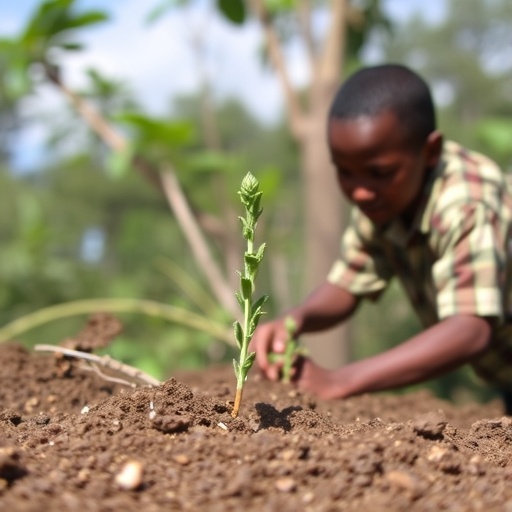In a groundbreaking study, researchers have uncovered critical insights into the survival rates and performance of seedlings planted for forest landscape restoration in the Oromia region of Ethiopia. This area, which has been significantly affected by deforestation and land degradation, presents an urgent need for effective strategies to restore its natural ecosystem. The research emphasizes the importance of understanding the dynamics of seedling survival and growth in order to develop successful reforestation initiatives that align with both ecological and socio-economic goals.
The comprehensive evaluation conducted by Garedew, Tesfaye, Gashaw, and their colleagues focused on a diverse range of seedling species commonly used in reforestation efforts. Their methods included detailed assessments of seedlings’ morphological and physiological traits, which play a pivotal role in their adaptability to the local environment. By analyzing these traits, the study provides valuable data that can inform the selection of species for future planting initiatives, ensuring that the chosen plants are well-suited to the unique conditions of the Oromia region.
One of the key findings from the research was the significant impact of microclimatic conditions on seedling survival rates. The team closely monitored variables such as sunlight exposure, soil moisture, and temperature variations across various planting sites. Their research revealed that seedlings planted in locations with optimal microclimatic conditions showed markedly higher survival and growth rates compared to those in harsher environments. This underscores the need for selecting appropriate planting sites that can facilitate the successful establishment of seedlings.
Moreover, the study highlights the crucial role of community involvement in forest restoration endeavors. Local communities are integral to the success of reforestation projects, as their traditional knowledge and participation can enhance the survival chances of newly planted seedlings. The researchers collaborated with local stakeholders to assess their experiences and perceptions regarding the restoration of forest landscapes, ultimately advocating for strategies that engage communities in all stages of the reforestation process.
Equally significant was the analysis of soil quality, which was found to be a determining factor in the growth performance of seedlings. The research team conducted soil tests to evaluate nutrient levels and organic matter content, revealing that richer soils tend to support healthier seedling growth. These findings suggest that soil remediation efforts could be beneficial in areas where soil degradation has occurred, further bolstering the efficacy of reforestation initiatives.
In addition to enhancing seedling survival, the study underscores the potential social and economic benefits of reforestation in the Oromia region. The restoration of forest landscapes not only contributes to biodiversity conservation but also provides local communities with vital resources such as timber, non-timber forest products, and improved water quality. By fostering a multi-faceted approach to forest restoration, the study advocates for initiatives that cater to both ecological integrity and local livelihoods.
Additionally, the researchers explored various management practices that could enhance the survival rates of seedlings. By implementing strategies such as protective shading, regular monitoring, and adaptive management techniques, their findings indicate that stakeholders can effectively increase the resilience of young trees against environmental stressors and improve overall restoration outcomes. The importance of continuous evaluation and adjustment of practices based on observations made in the field cannot be overstated.
Moreover, the collaboration between researchers and local farmers proved to be a valuable cornerstone of the study. The input garnered from farmers regarding their experiences with different seedling species provided essential insights that guided the research. This co-production of knowledge fosters a sense of ownership among the communities and promotes sustainable practices that resonate with local ecological conditions.
Understanding the complexities of regeneration in forest ecosystems is crucial for advancing reforestation efforts in Ethiopia and beyond. By focusing on key attributes such as seedling health, survival patterns, and adaptive management, the findings of this research not only contribute to academic discourse but also serve as a pragmatic guide for policymakers and practitioners aiming to combat forest degradation on a global scale.
As the world increasingly recognizes the critical role that forests play in climate regulation, carbon sequestration, and biodiversity preservation, this study emerges as a timely reminder of the importance of effective restoration strategies. The success achieved in the Oromia region could serve as a model for other regions facing similar challenges, promoting a restorative paradigm that balances ecological necessity with community welfare.
In conclusion, the research conducted by Garedew and colleagues opens up new pathways for innovative reforestation approaches in Ethiopia. Through a thorough examination of seedling survival and performance, the study lays the groundwork for future projects aimed at restoring forest landscapes and improving the quality of life for local communities. It encourages a collaborative approach that merges scientific inquiry with grassroots knowledge, offering a holistic solution to the urgent challenges of deforestation and ecosystem degradation.
Subject of Research: Seedling survival and performance in forest landscape restoration.
Article Title: Survival and performance of seedlings planted for forest landscape restoration in the Oromia region of Ethiopia.
Article References:
Garedew, E., Tesfaye, A., Gashaw, M. et al. Survival and performance of seedlings planted for forest landscape restoration in the Oromia region of Ethiopia. Discov Agric 3, 108 (2025). https://doi.org/10.1007/s44279-025-00256-x
Image Credits: AI Generated
DOI: 10.1007/s44279-025-00256-x
Keywords: Reforestation, seedling survival, forest restoration, Oromia, Ethiopia, community involvement, soil quality, adaptive management, ecological sustainability.




